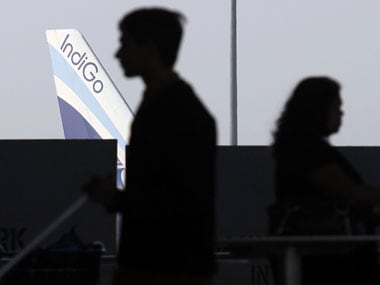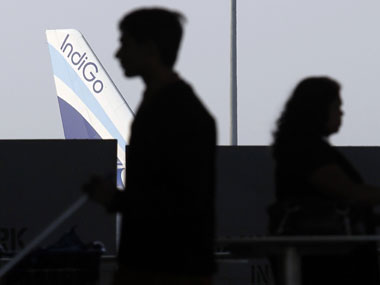(Editor’s note: This article is being republished with updates.) IndiGo is launching its initial public offering to raise Rs 3,018 crore today, the largest issue in India in nearly three years. Just before the IPO, the low-cost carrier kicked up a controversy for taking out cash to pay promoters hefty dividends, which pushed the company’s net worth into the negative territory. President and whole time director Aditya Ghosh, in a recent interaction defended the company’s move. He said the company was proud of its dividend record and does not plan to have a specific dividend policy in the future. He brushed aside concerns over the company having negative net worth of Rs 139 crore as of June 30, saying this figure is just worth 20 days’ profit for the company and that it began cash generation from July 1. He also said the company has cash reserves of close to Rs 3,600 crore as on date. [caption id=“attachment_2190771” align=“alignleft” width=“380”]
 Reuters[/caption] Here are 10 things to know about IndiGo, the largest airline in India by passengers, even as the company is gearing up for its upcoming public issue. 1) IndiGo has no plans to boost regional connectivity by buying aircraft smaller than the 180 seater Airbus 320s. The airline currently operates 97 aircrafts, and has 430 more on order. 2) IPO was the preferred route for raising funds for the company and not getting a foreign airline as equity partner as the latter could have diluted the LCC focus. Remember, Qatar Airways has been publicly wooing IndiGo but Ghosh again rebuffed Qatar, saying that though Qatar runs a good airline, but Indigo does not want to dilute focus on LCC model. 3) First quarter saw the company record a net profit of Rs 640 crore, with 15 percent EBIDTAR margin and revenue of Rs 4,317 crore. 4) In last 4 years, IndiGo generated Rs 836 crore in cash, while revenue CAGR stood at 38 percent and the company paid Rs 3,500 crore as dividends. 5) Tongue firmly in cheek, Ghosh alludes to competition but not by name: “We don’t do fire sales nor do Rs 30,000 fares. We don’t do red carpets….”. He says we have a battle hardy management team which has held its own through challenges in recent years when competitors could not face up to them, he adds. 6) Ghosh claims IndiGo generates highest number of ASKS (available seat kilometres which means capacity) in industry and aircraft utilisation is high at 11.4 block hours, again an industry high. 7) Ghosh says IndiGo remains fanatical about controlling costs. He says IndiGo’s total cost per unit excluding supplementary rentals is 5.59 cents, lowest among all Indian airlines. 8) IndiGo started off with lowest cost structure by ordering 100 aircraft even before starting. This large order helped negotiate discounts and bring in certainty into the system. Then, the airline also entered into long term contracts called “power by the hour” agreements, which helped costs immensely. 9) IndiGo says 22 of its 97 aircraft are owned, rest all are on operational lease. Short term lease means Indigo buys aircraft at discount, immediately sells it to lessor at market price thus making gains. It then leases planes back from lessor so that average fleet age is under 4 years since aircraft are on six year lease arrangements. 10) Young fleet means aircraft fuel consumption is lower, which keeps IndiGo’s fuel expenses lower. Besides, deliveries of A320neos will start in Q4 of this fiscal. These aircraft will deliver 10-15 percent better fuel efficiency which means 4-7 percent impact on total costs. Fleet size will be 111 aircraft by March 2016, 134 by March 2017 and 154 in March 2018. At its peak fleet, Indigo will have 330 aircraft.
Reuters[/caption] Here are 10 things to know about IndiGo, the largest airline in India by passengers, even as the company is gearing up for its upcoming public issue. 1) IndiGo has no plans to boost regional connectivity by buying aircraft smaller than the 180 seater Airbus 320s. The airline currently operates 97 aircrafts, and has 430 more on order. 2) IPO was the preferred route for raising funds for the company and not getting a foreign airline as equity partner as the latter could have diluted the LCC focus. Remember, Qatar Airways has been publicly wooing IndiGo but Ghosh again rebuffed Qatar, saying that though Qatar runs a good airline, but Indigo does not want to dilute focus on LCC model. 3) First quarter saw the company record a net profit of Rs 640 crore, with 15 percent EBIDTAR margin and revenue of Rs 4,317 crore. 4) In last 4 years, IndiGo generated Rs 836 crore in cash, while revenue CAGR stood at 38 percent and the company paid Rs 3,500 crore as dividends. 5) Tongue firmly in cheek, Ghosh alludes to competition but not by name: “We don’t do fire sales nor do Rs 30,000 fares. We don’t do red carpets….”. He says we have a battle hardy management team which has held its own through challenges in recent years when competitors could not face up to them, he adds. 6) Ghosh claims IndiGo generates highest number of ASKS (available seat kilometres which means capacity) in industry and aircraft utilisation is high at 11.4 block hours, again an industry high. 7) Ghosh says IndiGo remains fanatical about controlling costs. He says IndiGo’s total cost per unit excluding supplementary rentals is 5.59 cents, lowest among all Indian airlines. 8) IndiGo started off with lowest cost structure by ordering 100 aircraft even before starting. This large order helped negotiate discounts and bring in certainty into the system. Then, the airline also entered into long term contracts called “power by the hour” agreements, which helped costs immensely. 9) IndiGo says 22 of its 97 aircraft are owned, rest all are on operational lease. Short term lease means Indigo buys aircraft at discount, immediately sells it to lessor at market price thus making gains. It then leases planes back from lessor so that average fleet age is under 4 years since aircraft are on six year lease arrangements. 10) Young fleet means aircraft fuel consumption is lower, which keeps IndiGo’s fuel expenses lower. Besides, deliveries of A320neos will start in Q4 of this fiscal. These aircraft will deliver 10-15 percent better fuel efficiency which means 4-7 percent impact on total costs. Fleet size will be 111 aircraft by March 2016, 134 by March 2017 and 154 in March 2018. At its peak fleet, Indigo will have 330 aircraft.
IndiGo launches IPO today: 10 facts about the co, dividend controversy and its defence
Sindhu Bhattacharya
• October 27, 2015, 09:27:18 IST
President and whole time director Aditya Ghosh said the company was proud of its dividend record and does not plan to have a specific dividend policy in the future
Advertisement
)
End of Article